Welcome to Utah Drywall and Repair’s comprehensive guide on mastering drywall texture techniques. Drywall can be a bit of a mystery for many homeowners, but fear not! We’re here to demystify the process and provide you with a step-by-step guide that will turn you into a drywall texture pro. Whether you’re looking to refresh your living space or tackle a renovation project, our expert advice will ensure your walls look flawless.
Contents
Introduction
At Utah Drywall and Repair, we understand that not everyone is a drywall expert. That’s why we’ve put together this step-by-step guide to help you master the art of drywall texturing. Whether you’re a seasoned DIY enthusiast or a first-time homeowner, our guide will equip you with the knowledge and skills needed to achieve professional-looking results.
Understanding Drywall Texture
Drywall texture is a technique used to add dimension and character to your walls. It involves applying a compound mixture to the drywall surface to create different patterns and textures. These textures not only enhance the aesthetics of your space but also serve functional purposes like hiding imperfections and improving acoustics.
Essential Tools and Materials
Before you dive into texturing, gather the necessary tools and materials. At Utah Drywall and Repair, we recommend investing in high-quality supplies for the best results. Here’s a list of what you’ll need:
- Drywall compound
- Texture sprayer or roller
- Trowels and putty knives
- Sandpaper
- Safety gear (goggles, gloves, mask)
- Drop cloths
- Paint and primer (optional)
Preparing Your Workspace
Creating a clean and organized workspace is crucial for a successful drywall texture project. Remove furniture and cover floors and fixtures with drop cloths to protect them from splatters. Ensure good ventilation in the area to aid in the drying process.
Step 1: Surface Preparation
Before applying texture, your walls need to be in tip-top shape. Inspect for cracks, holes, or imperfections, and patch them up with a joint compound. Sand the surface to create a smooth base for texture application.
Step 2: Choosing the Right Texture
There are various drywall textures to choose from, including orange peel, knockdown, and popcorn. Consider the style you want to achieve and select the appropriate texture. Utah Drywall and Repair can provide samples and recommendations based on your preferences.
Step 3: Mixing Texture Compound
Mix the drywall compound to the desired consistency. It should be thick enough to hold its shape but thin enough to spray or roll onto the wall. Follow the manufacturer’s instructions for the best results.
Step 4: Applying the Texture
Now comes the fun part—applying the texture! Use a texture sprayer or roller to evenly coat the wall with the compound. Work in small sections, and be mindful of the pattern you’re creating. Utah Drywall and Repair experts can offer guidance on technique.
Step 5: Perfecting the Finish
After applying the texture, let it dry completely. Once dry, lightly sand the surface to smooth out any rough spots. You can then proceed with painting if desired, and your walls will look brand new.
FAQs
What is drywall texture, and why is it important?
Drywall texture is a decorative and functional technique used to add character to walls while concealing imperfections.
Can I texture my walls without professional help?
Absolutely! With the right tools, materials, and guidance, anyone can master drywall texture techniques.
What are the different types of drywall textures?
Common textures include orange peel, knockdown, and popcorn. Each has its unique look and application method.
How do I fix mistakes in the texture application?
Minor mistakes can be sanded and touched up with additional texture compound. For major errors, it’s best to consult professionals.
Is there a way to match existing textures during repairs?
Yes, it’s possible to match existing textures by carefully replicating the pattern and using the same texture compound.
Now that you’ve learned the art of mastering drywall texture techniques, it’s time to put your newfound skills to the test. Utah Drywall and Repair is here to support you every step of the way. For expert advice, quality materials, and professional service, contact us at 801-406-6350 or visit our website drywallrepairutah.com.




